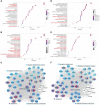Roles of Altered Macrophages and Cytokines: Implications for Pathological Mechanisms of Postmenopausal Osteoporosis, Rheumatoid Arthritis, and Alzheimer's Disease
- PMID: 35757427
- PMCID: PMC9226340
- DOI: 10.3389/fendo.2022.876269
Roles of Altered Macrophages and Cytokines: Implications for Pathological Mechanisms of Postmenopausal Osteoporosis, Rheumatoid Arthritis, and Alzheimer's Disease
Abstract
Postmenopausal osteoporosis (PMOP) is characterized by the uncoupling of bone resorption and bone formation induced by estrogen deficiency, which is a complex outcome related to estrogen and the immune system. The interaction between bone and immune cells is regarded as the context of PMOP. Macrophages act differently on bone cells, depending on their polarization profile and secreted paracrine factors, which may have implications for the development of PMOP. PMOP, rheumatoid arthritis (RA), and Alzheimer's disease (AD) might have pathophysiological links, and the similarity of their pathological mechanisms is partially visible in altered macrophages and cytokines in the immune system. This review focuses on exploring the pathological mechanisms of PMOP, RA, and AD through the roles of altered macrophages and cytokines secretion. First, the multiple effects on cytokines secretion by bone-bone marrow (BM) macrophages in the pathological mechanism of PMOP are reviewed. Then, based on the thought of "different tissue-same cell type-common pathological molecules-disease pathological links-drug targets" and the methodologies of "molecular network" in bioinformatics, highlight that multiple cytokines overlap in the pathological molecules associated with PMOP vs. RA and PMOP vs. AD, and propose that these overlaps may lead to a pathological synergy in PMOP, RA, and AD. It provides a novel strategy for understanding the pathogenesis of PMOP and potential drug targets for the treatment of PMOP.
Keywords: Alzheimer’s disease; cytokines; macrophages; postmenopausal osteoporosis; rheumatoid arthritis.
Copyright © 2022 Xu, Yan, Zhang, Zhuo, Han, Zhang, Xie, Lan, Cai, Wang, Wang and Li.
Conflict of interest statement
The authors declare that the research was conducted in the absence of any commercial or financial relationships that could be construed as a potential conflict of interest.
Figures



Similar articles
-
Postmenopausal osteoporosis in rheumatoid arthritis: The estrogen deficiency-immune mechanisms link.Bone. 2017 Oct;103:102-115. doi: 10.1016/j.bone.2017.06.020. Epub 2017 Jun 27. Bone. 2017. PMID: 28666971 Review.
-
Identification of Serum Exosome-Derived circRNA-miRNA-TF-mRNA Regulatory Network in Postmenopausal Osteoporosis Using Bioinformatics Analysis and Validation in Peripheral Blood-Derived Mononuclear Cells.Front Endocrinol (Lausanne). 2022 Jun 9;13:899503. doi: 10.3389/fendo.2022.899503. eCollection 2022. Front Endocrinol (Lausanne). 2022. PMID: 35757392 Free PMC article.
-
Interaction between bone and immune cells: Implications for postmenopausal osteoporosis.Semin Cell Dev Biol. 2022 Mar;123:14-21. doi: 10.1016/j.semcdb.2021.05.014. Epub 2021 May 20. Semin Cell Dev Biol. 2022. PMID: 34024716 Review.
-
The relationship between bone marrow adipose tissue and bone metabolism in postmenopausal osteoporosis.Cytokine Growth Factor Rev. 2020 Apr;52:88-98. doi: 10.1016/j.cytogfr.2020.02.003. Epub 2020 Feb 10. Cytokine Growth Factor Rev. 2020. PMID: 32081538 Review.
-
Bone Marrow Adipose Tissue as a Critical Regulator of Postmenopausal Osteoporosis - A Concise Review.Clin Interv Aging. 2024 Jul 11;19:1259-1272. doi: 10.2147/CIA.S466446. eCollection 2024. Clin Interv Aging. 2024. PMID: 39011312 Free PMC article. Review.
Cited by
-
Research progress of targeted therapy regulating Th17/Treg balance in bone immune diseases.Front Immunol. 2024 Jan 30;15:1333993. doi: 10.3389/fimmu.2024.1333993. eCollection 2024. Front Immunol. 2024. PMID: 38352872 Free PMC article. Review.
-
Network Analysis of Brain and Bone Tissue Transcripts Reveals Shared Molecular Mechanisms Underlying Alzheimer's Disease and Related Dementias and Osteoporosis.J Gerontol A Biol Sci Med Sci. 2024 Nov 1;79(11):glae211. doi: 10.1093/gerona/glae211. J Gerontol A Biol Sci Med Sci. 2024. PMID: 39194133
-
Mechanisms by which kidney-tonifying Chinese herbs inhibit osteoclastogenesis: Emphasis on immune cells.Front Pharmacol. 2023 Feb 6;14:1077796. doi: 10.3389/fphar.2023.1077796. eCollection 2023. Front Pharmacol. 2023. PMID: 36814488 Free PMC article. Review.
-
Rheumatoid arthritis is a protective factor against Alzheimer's disease: a bidirectional two-sample Mendelian randomization study.Inflammopharmacology. 2024 Feb;32(1):863-871. doi: 10.1007/s10787-023-01397-5. Epub 2023 Dec 27. Inflammopharmacology. 2024. PMID: 38151584
-
Macrophages and Bone Remodeling.J Bone Miner Res. 2023 Mar;38(3):359-369. doi: 10.1002/jbmr.4773. Epub 2023 Feb 3. J Bone Miner Res. 2023. PMID: 36651575 Free PMC article. Review.
References
Publication types
MeSH terms
Substances
LinkOut - more resources
Full Text Sources
Medical

